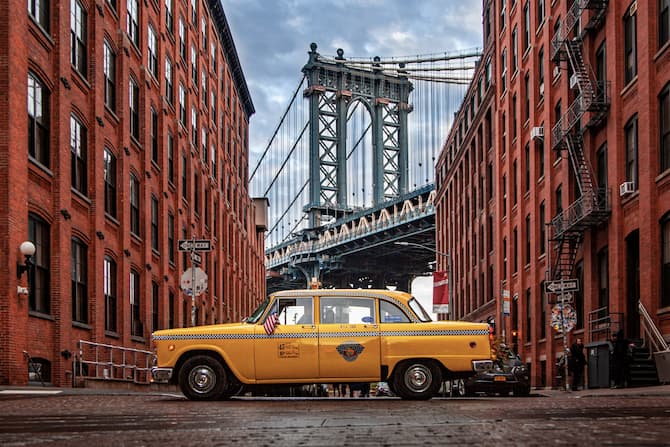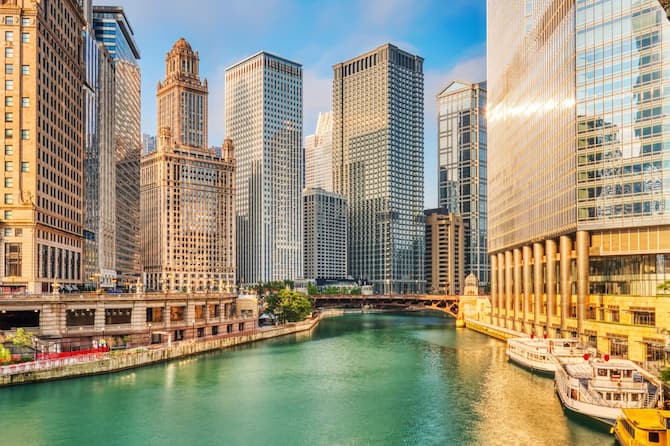
From the revolutionary stirrings on the cobbled streets of colonial New York to the lasting echoes of Reconstruction in Charlotte, this East Coast road trip is more than just a scenic drive; it’s a journey through the story of a nation.
Each stop along the way brings to life a different chapter of American history, from the founding ideals that shaped the republic to the hard-fought battles that redefined its identity.
In this guide, we trace a route south from New York City to Charlotte, spotlighting must-see landmarks, offering practical tips to make the most of your time, and featuring Sonesta hotels conveniently located near the heart of the action.
Table of Contents
- Planning the Path: Tips for a Meaningful Journey Across East Coast
- 1. Starting Point: New York City, NY—Revolutionary Beginnings
- 2. First Stop: Philadelphia, PA – Forging Independence
- 3. Second Stop: Baltimore, MD—War of 1812 Stronghold
- 4. Midpoint: Washington, D.C. – America’s Historical Heart
- 5. Civil War Crossroads: Fredericksburg & Richmond, VA
- 6. Brief Stop: Durham, NC – The War’s Final Turning Point
- 7. Final Destination: Charlotte, NC – The South’s Transformation
- Wrapping Up the Journey
- Related Guides: Plan Your Next Adventure with Sonesta
Planning the Path: Tips for a Meaningful Journey Across East Coast
A road trip from New York City to Charlotte is more than just a drive; it’s an opportunity to engage with the nation’s past mile by mile. Here’s how to make the most of your experience.
Ideal Itinerary Length
For travelers who want time to explore, reflect, and enjoy the journey without rushing, a five- to six-day itinerary hits the sweet spot.
The route covers approximately 600 miles, and with daily drives ranging from 1 to 3.5 hours, you’ll have ample time to linger at key sites and discover hidden gems.
Pacing the Drive
While the total driving time clocks in around 10 to 12 hours without stops, this trip is best taken slowly. For a more scenic and historically immersive ride, consider veering off I-95:
- Route 1 between New York City and Philadelphia offers small-town charm and Revolutionary War landmarks.
- Route 301 from Washington, D.C. to Richmond provides a quieter, less congested alternative with Southern character and Civil War history.
When to Go
Spring and fall are ideal. April, May, September, and October offer mild temperatures, fewer crowds, and beautiful natural light for photography.
If you’re hoping to avoid packed museums and long security lines, it’s best to steer clear of peak holidays like Memorial Day or the Fourth of July, especially around D.C.
What to Bring
For a journey like this, packing a few thoughtful items can enrich the experience. A travel journal to capture reflections and memorable details, and a camera for snapshots and storytelling.
Consider bringing a book or two that complements the route, 1776 by David McCullough or Battle Cry of Freedom by Shelby Foote add rich context along the way.
What It Might Cost
A rough breakdown of typical costs, include:
Gas and tolls will likely run between US$120–US$180 in total, depending on then-current gas prices, type of vehicle and the chosen route.
Admission to most historical sites ranges from US$0 to US$15 per person, with many offering free guided tours or audio apps.
Lodging rates vary by season and hotel style. The nightly rate at our featured Sonesta properties along the route typically ranges from US$90 to US$290. For 5 to 6 nights, you can reasonably expect to spend between US$600 and US$1,400, depending on the season and property type.
For the most up-to-date pricing, explore Sonesta’s featured hotels in:
A Few Handy Tools
Apps like Clio and the National Park Service app are great travel companions, offering maps, background info, and real-time updates on historic landmarks as you go.
Stay Smarter with Sonesta Travel Pass
With Sonesta hotels at key stops along the route, the Sonesta Travel Pass loyalty program adds extra value to your stay.
Members earn points toward free nights and enjoy exclusive rates, room upgrades, and other tier-based perks like late checkout and bonus point multipliers. It’s free to join and worth considering if you’re planning more than just one trip.
1. Starting Point: New York City, NY—Revolutionary Beginnings
New York City offers more than a skyline; it’s where colonial resistance began to transform into a revolution.
In the streets of Lower Manhattan, the early sparks of independence were struck, and the country’s first steps as a new republic took form. For history lovers, it’s the perfect place to launch a journey through the nation’s past.
Fraunces Tavern Museum
Step into the heart of Revolutionary history at Fraunces Tavern, a 1719 landmark that once buzzed with plots for independence.
This was a gathering place for the Sons of Liberty and the emotional site of George Washington’s farewell to his officers at the end of the Revolutionary War. Today, it stands as a museum, offering restored period rooms, rare artifacts, and rotating exhibits that bring colonial New York vividly to life. Admission is about US$7 per person.
- Address: 54 Pearl St, New York, NY 10004
- Map It: View Directions
Federal Hall National Memorial
Just a few blocks away, Federal Hall stands on the very site where George Washington took the oath of office as the nation’s first president. This historic spot also served as home to the first U.S. Congress and the Supreme Court.
Housed in a striking neoclassical building, the memorial now functions as a museum exploring the foundations of the early republic. Admission is free, making it an essential and accessible stop for history lovers.
- Address: 26 Wall St, New York, NY 10005
- Map It: View Directions

Federal Hall NYC where Washington took his first oath and the early U.S. government first convened now a museum of the republic
Trinity Churchyard
Tucked into the heart of Lower Manhattan, Trinity Churchyard offers a quiet moment of reflection amid the city’s bustle. Here you’ll find the graves of Alexander Hamilton and his wife Eliza, a poignant reminder of the personal stories behind America’s founding.
It’s a brief stop, but a deeply moving one that connects the nation’s history to some of the individuals who shaped it.
- Address: 89 Broadway, New York, NY 10006
- Map It: View Directions
Suggested Timing
Spend about five hours exploring these sites at a relaxed pace. Start your morning at Fraunces Tavern Museum, then walk to Federal Hall by midday. Wrap up at Trinity Churchyard and enjoy lunch nearby—The Dead Rabbit is a fitting choice for its colonial-style fare and ambiance.
One night in NYC allows just enough time to explore before heading to Philadelphia the next day.
Where to Stay in NYC
Whether you’re looking for a boutique escape or a suite that feels like home, Sonesta offers a range of NYC stays to suit every travel style. With convenient locations in and around Midtown Manhattan, you’ll be within easy reach of the city’s top Revolutionary War sites and historic attractions.
2. First Stop: Philadelphia, PA – Forging Independence
In Philadelphia, revolution gave way to nationhood. This is where the founding ideals of liberty, equality, and self-governance were not only debated but committed to paper; forever shaping the course of history.
A visit to Philly offers a front-row seat to the creation of the Declaration of Independence and the U.S. Constitution, two of the most influential documents ever written.
Museum of the American Revolution
Begin your visit to Philadelphia with an immersive look at the fight for independence at the Museum of the American Revolution.
This modern museum weaves together artifacts, personal stories, and interactive exhibits to give rich context to the founding era. It’s an ideal introduction before heading to Independence Hall. Admission is approximately US$24 per adult.
- Address: 101 S 3rd St, Philadelphia, PA 19106
- Map It: View Directions
Independence Hall
Step into the very room where both the Declaration of Independence and the U.S. Constitution were fiercely debated and ultimately signed. A UNESCO World Heritage Site, Independence Hall is one of the most significant civic buildings in American history.
Timed entry tickets are required, and reservations are highly recommended. Admission is just $1 per person.
- Address: 520 Chestnut St, Philadelphia, PA 19106
- Map It: View Directions
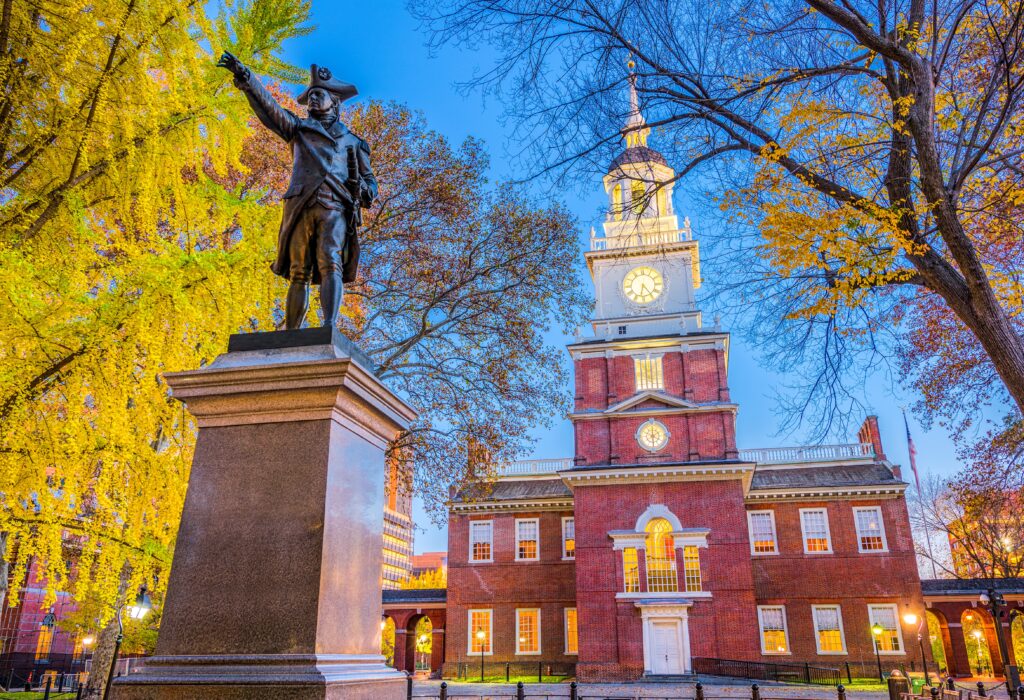
Independence Hall Philadelphia where the Declaration and Constitution were debated and signed now a symbol of America’s founding ideals
Liberty Bell Center
Just steps from Independence Hall, the Liberty Bell remains one of America’s most powerful symbols of freedom. Though it no longer rings, its iconic crack and timeless inscription “Proclaim Liberty Throughout All the Land” continues to resonate across generations.
Admission is free and offered on a first-come, first-served basis, so arriving early is a good idea during peak hours.
- Address: 526 Market St, Philadelphia, PA 19106
- Map It: View Directions
Suggested Timing
Depart NYC around 8:00 AM to arrive in Philadelphia by mid-morning. Start at the Museum of the American Revolution around 10:30 AM, followed by a timed visit to Independence Hall.
Afterward, explore the Liberty Bell Center at your own pace. Wrap up with lunch at City Tavern (or another historic-inspired restaurant nearby) before checking into your hotel.
Consider staying the night to round out your visit, then set your sights on the next chapter of the trip.
Where to Stay
From upscale, full-service hotels to modern stays designed for comfort and convenience, Sonesta offers a range of options in Philadelphia, including Sonesta Philadelphia Rittenhouse Square, located just steps from the city’s historic core.

Sonesta Philadelphia Rittenhouse Square
3. Second Stop: Baltimore, MD—War of 1812 Stronghold
Baltimore played a pivotal role in defending the young republic. During the War of 1812, the city’s resilience helped inspire a national anthem and a sense of identity that still resonates today.
A quick stop here offers a vivid window into the era when America proved it could endure.
Fort McHenry National Monument
This star-shaped coastal fort famously held strong during the 1814 Battle of Baltimore, successfully defending the harbor from British attack. When the smoke cleared, the sight of the American flag still flying inspired Francis Scott Key to write what would become the national anthem: “The Star-Spangled Banner.”
Today, visitors can walk the ramparts, tour historic barracks, explore interactive exhibits, and witness the daily flag-raising ceremony. Admission is around US$15 per person.
- Address: 2400 E Fort Ave, Baltimore, MD 21230
- Map It: View Directions

Fort McHenry in Baltimore defended the harbor during the War of 1812 and inspired the words to the U.S. national anthem.
Star-Spangled Banner Flag House
Just a short drive from Fort McHenry, this historic home belonged to Mary Pickersgill, the seamstress who crafted the massive flag that inspired “The Star-Spangled Banner.”
The museum offers a glimpse into life in 1812, with exhibits on Pickersgill’s work, the making of the flag, and the enduring legacy of the national anthem. Admission is about $9 per person.
- Address: 844 E Pratt St, Baltimore, MD 21202
- Map It: View Directions
Suggested Timing
Start your morning at Fort McHenry to take in the full visitor experience and walking tour, then head to the Flag House by early afternoon. For lunch or a snack before hitting the road, stop by Lexington Market, one of the oldest public markets in the U.S., known for its local flavor and historic vibe.
Baltimore’s sites can be easily explored in a few hours, so it fits naturally into the route toward Washington, D.C. If you’re in the mood to take your time, it’s also a worthwhile place to stay the night before heading south.
Where to Stay
If you’re spending the night in Baltimore, Sonesta offers a range of delightful stays throughout the area—from luxuriously appointed hotels to affordable, homelike accommodations.
4. Midpoint: Washington, D.C. – America’s Historical Heart
Few cities capture the breadth of the American story quite like Washington, D.C. From the ideals of the Revolution to the reckonings of the Civil War and beyond, the nation’s capital reflects both the aspirations and growing pains of a young republic.
A visit here offers not just monuments and museums, but a powerful sense of continuity, symbolism, and depth that stretches across centuries.
National Archives Museum
See the very documents that launched a nation. The Declaration of Independence, U.S. Constitution, and Bill of Rights are all preserved and displayed in the museum’s Rotunda for the Charters of Freedom. Timed entry is free, but reservations are strongly recommended (especially during the busy spring and summer seasons).
- Address: 701 Constitution Ave NW, Washington, D.C. 20408
- Map It: View Directions
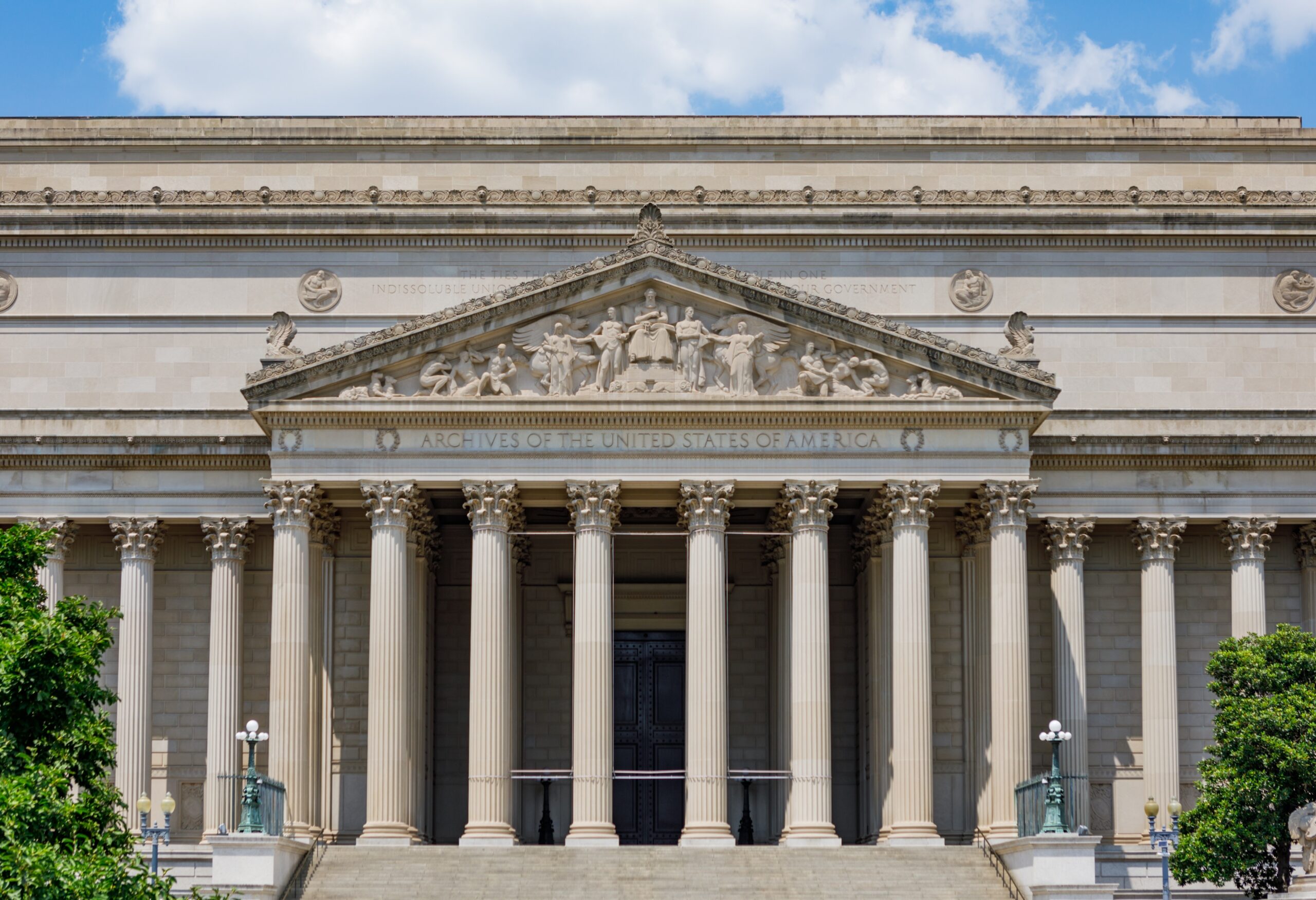
National Archives, Washington D.C. where the Declaration of Independence, Constitution, and Bill of Rights are preserved and displayed for public view.
Smithsonian National Museum of American History
This sweeping collection captures everything from George Washington’s uniform to Abraham Lincoln’s top hat. It’s an engaging place to explore the layers of American life, conflict, and culture. Admission is free.
- Address: 1300 Constitution Ave NW, Washington, D.C. 20560
- Map It: View Directions
Ford’s Theatre
Walk through the historic theater where President Abraham Lincoln was assassinated in 1865, a moment that forever changed the course of American history. Ford’s Theater is both a working theater and a historic museum.
The museum features artifacts from that fateful night, and guided tours provide a thoughtful, immersive look at one of the nation’s most defining tragedies. Admission ranges from US$3 to US$5.
- Address: 511 10th St NW, Washington, D.C. 20004
- Map It: View Directions
Suggested Timing
Start your day at the National Archives Museum with a reserved morning slot, followed by several hours at the Museum of American History. Wrap up with a visit to Ford’s Theatre before dinner—Old Ebbitt Grill, just a short walk away, adds a historic touch to the evening.
With so much to see and absorb, spending two nights in the D.C. area allows time to explore without rushing.
Where to Stay
Sonesta offers a variety of convenient and comfortable stays in the D.C. area, including well-located options just across the river in Arlington, Virginia. With quick access to the Metro system, these hotels make an ideal home base for exploring the capital’s top monuments, museums, and historic sites without the hassle of city-center traffic or parking.
5. Civil War Crossroads: Fredericksburg & Richmond, VA
As you travel deeper into Virginia, the journey takes you through two cities that bore witness to some of the most pivotal and painful chapters of the Civil War.
From the front lines of Fredericksburg to the political heart of the Confederacy in Richmond, these stops offer a powerful lens into the nation’s internal conflict, the weight of leadership, and the long, complex road toward Reconstruction.
Fredericksburg and Spotsylvania National Military Park
This expansive historic site spans four major battlefields, Fredericksburg, Chancellorsville, The Wilderness, and Spotsylvania Court House, capturing the scale and brutality of one of the Civil War’s most intense campaigns.
Start at the Fredericksburg Battlefield Visitor Center for essential background, maps, and exhibits before heading out on a self-guided driving tour through these hauntingly preserved landscapes. Admission is free, with parking available for around $2.
- Address: 1013 Lafayette Blvd, Fredericksburg, VA 22401
- Map It: View Directions
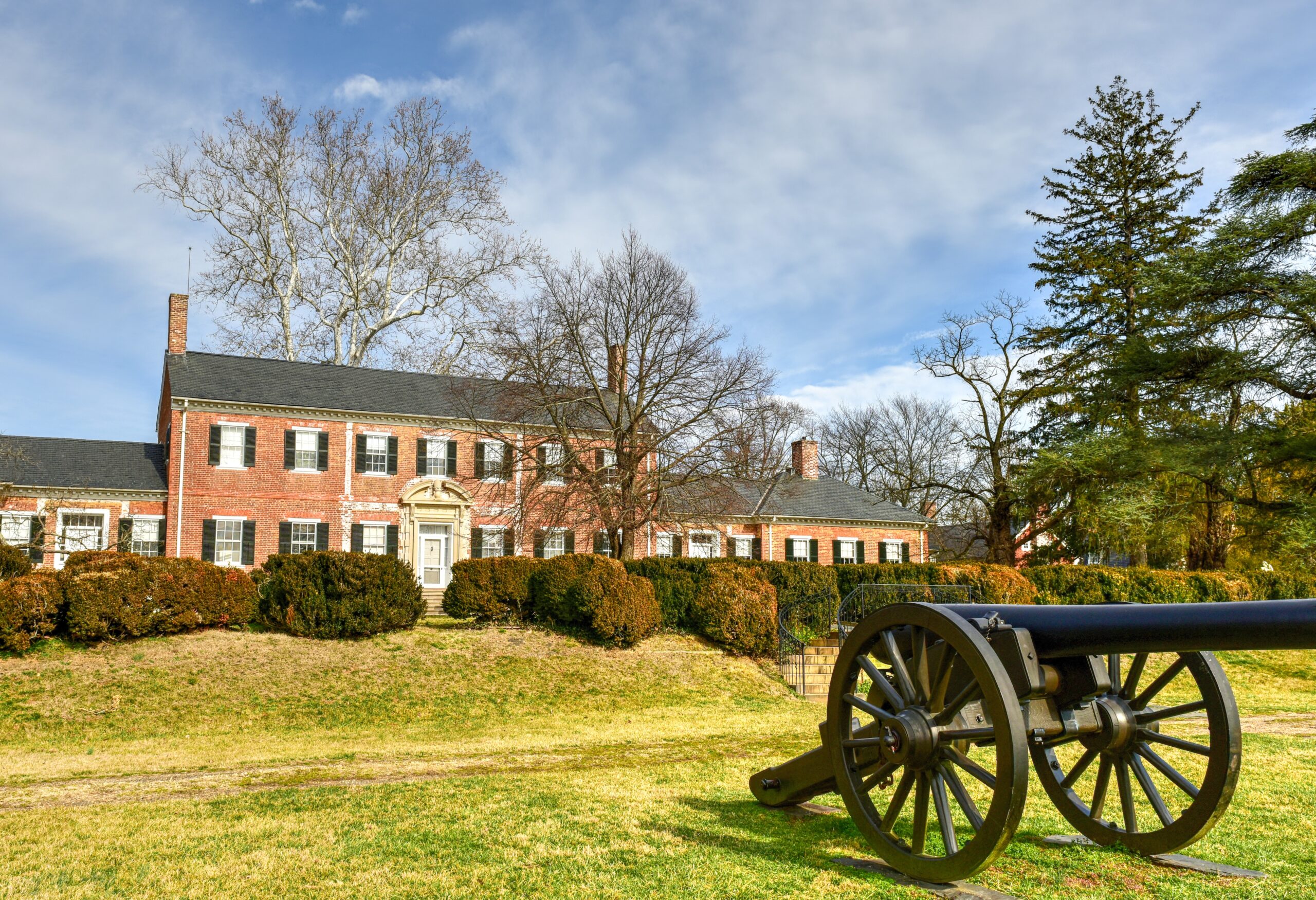
Once a key Civil War command post, this site at Fredericksburg’s battlefield park now preserves stories of strategy, sacrifice, and turning points in U.S. history.
American Civil War Museum at Historic Tredegar (Richmond)
Set along the James River in a former Confederate ironworks, the American Civil War Museum offers a modern perspective on the conflict that divided the nation.
Through personal stories, authentic artifacts, and immersive exhibits, the museum explores the Civil War from multiple viewpoints, giving visitors a fuller understanding of the war’s complexity and legacy.
Admission is around US$15 per person.
- Address: 500 Tredegar St, Richmond, VA 23219
- Map It: View Directions
Suggested Timing
Those interested in a deeper dive into Civil War history can plan a full day to visit both cities.
If you’re short on time, Fredericksburg makes a meaningful stop for a battlefield walk before continuing to Richmond for lunch and a museum visit. Both cities are easily explored in a combined half- to full-day depending on your pace.
Where to Stay
For travelers looking to break up the drive with an overnight stop, Sonesta offers affordable, no-frills options in both towns, ideal for a quick layover before continuing south.
6. Brief Stop: Durham, NC – The War’s Final Turning Point
Just a short detour off I-85, Durham offers a final, often overlooked chapter in Civil War history before the road turns toward the South’s transformation.
Quiet and reflective, this stop marks the site of the largest troop surrender of the war, symbolizing not just the end of conflict, but the beginning of national reconstruction. It’s a powerful pause that brings closure to the war’s long shadow.
Bennett Place Historic Site
This unassuming farmhouse was the site of the largest Confederate troop surrender of the Civil War, effectively marking the true end of the conflict in April 1865.
Today, visitors can walk the peaceful grounds, explore a small but informative museum, and view a short film that puts the surrender in historical context. Admission is free.
- Address: 4409 Bennett Memorial Rd, Durham, NC 27705
- Map It: View Directions
Suggested Timing
Plan for 45 minutes to an hour to explore the grounds and visitor center before continuing the final stretch to Charlotte.
Where to Stay
If your visit to Durham stretches into the day, Sonesta offers a variety of convenient hotels in the area, from modern properties to all-suite accommodations.
7. Final Destination: Charlotte, NC – The South’s Transformation
Charlotte brings the journey full circle. While it’s known today as a thriving financial hub, the city also holds stories of colonial foundations, Civil War tensions, and the cultural evolution that followed. Past and present converge here, offering a fitting place to conclude the trip.
President James K. Polk State Historic Site
Located just south of Charlotte in Pineville, this site preserves the birthplace of James K. Polk, the 11th president of the United States.
Visitors can tour reconstructed log cabins, explore exhibits on westward expansion, and learn how Polk’s presidency helped shape the boundaries of modern America, offering a fitting presidential footnote to the final leg of your journey. Admission is about US$2 per person.
- Address: 12031 Lancaster Hwy, Pineville, NC 28134
- Map It: View Directions
Charlotte Museum of History
This thoughtfully curated museum traces Charlotte’s story from its colonial roots to its Revolutionary role and beyond. At its heart is the Hezekiah Alexander House, a remarkably preserved stone home built in 1774, offering a rare glimpse into 18th-century frontier life.
Surrounding exhibits explore the city’s early settlement, civic development, and Charlotte’s evolving influence in the region, making it a perfect final stop to reflect on how the past continues to shape the South.
- Address: 3500 Shamrock Dr, Charlotte, NC 28215
- Map It: View Directions
Levine Museum of the New South
Focusing on life in the South after the Civil War, the Levine Museum offers a compelling, story-driven look at Reconstruction, segregation, the civil rights movement, and the transformation of Charlotte into a modern urban center.
With hands-on exhibits and personal narratives, the museum brings to life the social and economic changes that have shaped the region over the last 150 years. Admission is about $10 per person.
- Address: 401 S Tryon St, Charlotte, NC 28202
- Map It: View Directions
Suggested Timing
Begin your day at the Charlotte Museum of History, where you can explore the city’s colonial roots and tour the 1774 Hezekiah Alexander House.
In the early afternoon, head uptown to the Levine Museum of the New South for an immersive look at post–Civil War Southern life and the evolution of modern Charlotte. Next, take a short drive south to Pineville to visit the President James K. Polk State Historic Site, adding a presidential note to your journey’s closing chapter.
Wrap up the day with dinner at Mert’s Heart & Soul, a beloved local spot known for its warm atmosphere and classic Southern comfort food.
Spending one or two nights in Charlotte gives you time to explore, unwind, and reflect before your East Coast road trip comes to a close.
Where to Stay
Sonesta offers a range of stays in Charlotte, from thoughtfully designed hotels to spacious, apartment-style suites. Whether you’re winding down after a week on the road or looking to explore more of the city, you’ll find comfort and convenience close to the area’s top historic and cultural sites.
Wrapping Up the Journey
A historical East Coast road trip from New York to Charlotte offers more than just scenic miles, it’s a chance to walk through the chapters of America’s story.
From Revolution to Reconstruction, each stop brings the past into sharper focus. With mapped-out sites, thoughtful pacing, and Sonesta hotels conveniently located along the way, this journey is as enriching as it is unforgettable.
Get your camera and journals ready!
Related Guides: Plan Your Next Adventure with Sonesta
Disclaimer: The suggested itinerary and points of interest are provided for informational and planning purposes only. Guests are encouraged to independently verify opening hours, availability, travel times, and any potential changes prior to visiting. The inclusion of any businesses, attractions, or destinations does not imply affiliation with or endorsement by Sonesta or its affiliates. Sonesta makes no representations or warranties regarding the accuracy or completeness of the information provided and assumes no responsibility for any inconvenience or loss arising from the use of this information.
